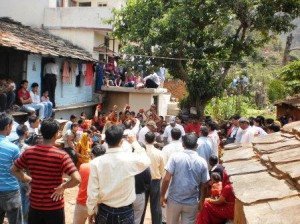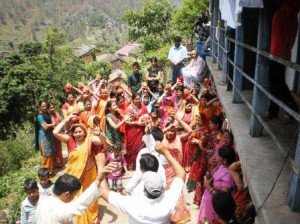One of our village mango tree called ‘Lamtharya’, known for its distinct flavor and sweetness could not bear the brunt of heavy rain and storm and was eventually uprooted in the month of April 2014. I came to know of it after seeing my nephew Babbe’s post on facebook with photo and news that ‘Lamtharya’ has been uprooted. Many of our villagers send their nostalgic comments on the sad event.
For me the uprooting of this tree, also symbolizes the uprooting of the village, though in gradual process since the early seventies. What was the storm that uprooted most of the village families? This troubled my mind and made me look into the social history of the village.
I realized that my village was a part of the larger picture of the same social history unfolding in the state of Uttarakhand
Every year since 2010, the Chai Gram Utsav is making an effort to uphold and preserve the culture and traditions of the region and to discuss and plan what best could be done on the development front. Every year inidividuals from development sector are invited to the Gram Utsav to contribute in this effort.


In the fifth year of Chai Gram Utsav-2014, we plan to come out with a souvenir magazine. When my cousin Padmesh told me to write something for the Gram Utsav magazine, I was really at loss to think on a topic, though he had given me brief on the possible topics.
The Lamtharya incident gave me the starting point, which actually triggered after reading the sentiments expressed by people on the facebook. Had people and families stayed back, the village would have had at least 300 families but today it is reduced to mere 6 to 8 families, who are permanently resident.
This is noticed when non resident families assembles at the time of Gram Utsav and share common interest and tastes for three days.
Many of the new generation may not have even tasted the Lamtharya mango flavor and sweetness. The new generations comes for a holiday at that time despite lack of urban amusements and modern amenities, though today the village is connected by road, has water supply, electricity and nearly all the houses have toilets.
The uprooted generation talks of good times and are invariably nostalgic about their childhood, adolescent and youthful days in the village. This is the generations which enjoys the old folk songs and understands the meaning and nuances in the lyrics of Narendra Singh Negi.
The new generation does not have much in common to share about village life, so the uprooting of the old tree will not be of any significance to them; however they may be interested to know the social history of the village.
Agriculture has always been of subsistence level and was supplemented by income from other sources. Almost every family had a member working in some government and or private service and their salary helped the joint family system.
Some karmkandi pundits supplemented the joint family income. Few of them even had their jajmani in the plains of western UP. These pundits would leave the village for their Jajmani around April/May and come back only around September/October.
The social history of Uttarakhand is reflected even in our village and vice versa. In post independent period many of the hill folks started buying land and later settled down in the Terai-foothills.
The Ex-Servicemen who fought in the Second World War were offered land in the foothills by the government in early fifties. Two of Chai’s ex-servicemen were also allotted land in the terai region of Bijnore district. They move with their families only in late fifties. Later other brothers and their family also joined them in early sixties.
Today we have few Chai families settled in the Kadarbbad tehsil of Bijnore district. One can see many families of former ex-servicemen of the state well settled in the entire stretch of the terai-foothill region of the state.
In early fifties two to three youth were employed with the central government in Delhi. Soon after marriage they took their spouses with them and raised their family there. Later their children were employed in and around Delhi. Today many families have settled in the NCR-Delhi, Faridabad and Gaziabad.
Subsequently uncles and brothers helped each other to get jobs and to settle there. Some who retired from government and private services also settled in NCR. Some of those who retired from service also settled in Kotdwar and Dehradun. Families moved out gradually in the seventies and the momentum caught on in the eighties and peaked in the nineties.
The first generation of Uttarakhandi who left their village was due to the ‘Pull factor’ of employment and job opportunities. Subsequently literacy level, realizing the value of education indirectly pulled people to leave their village.
Today the ‘push factor’ is lack of livelihood options besides the poor educational facilities. The manufacturing and service sector in the state is still underdeveloped and with no income from agriculture, people had no choice but to leave their ancestral village.
Till late sixties, majority of the people of Uttarakhand lived in their villages and those working outside came regularly on all major occasions, holidays and on leave to the village. Witnessing the development in the plains, men in seventies, started taking their spouse and children with them.
In the eighties those retiring from service started building their houses in the plains. By the nineties those who could afford followed the same pattern of permanently settling in the plains.
Till late sixties there was no road connecting majority of the hill villages, no electricity, water system and students had to walk many miles to school. Some development came in 80’s and 90’s, by which time many of the families had settled or planned to move out of the village. This is also the period when agriculture activities started diminishing and today major crops like Wheat.
Rice, Pulses and Millets are no more grown, except some vegetables in the kitchen garden. Due to this even animal husbandry has stopped and one hardly finds fresh milk in the village. All this happened gradually and hence today even if the wild boar and monkey problem is solved, agricultural activities will not be revived as most of the families have left the village.
Chai village is a case study and similar phenomenon can be seen in other villages of Uttarakhand. Many villages have been deserted or on the verge of desertion. With no job and income source in the village, the general feeling is that, if everything had to be bought from the market, why keep the family behind in the village.
Many families have also moved out to nearby town and cities to give better education to their children.
Development and prosperity in the hills is yet to be seen even after a decade of state formation. Villagers are still getting deserted and the youth is still going out for employment. The 2011 census authenticate this, by showing the demographic shift from the hills to the foothills and in the plains.
The political class has no vision and mission and the uncommitted bureaucracy is just maintaining the state machinery without any concrete policy and plan. I don’t know if academicians, development experts and planners have any blueprint on hill development. In the prevailing situation, soon Chai will be another village added in the list of deserted village of Uttarakhand.
The Author is development consultant, email: ghughuti@gmail.com